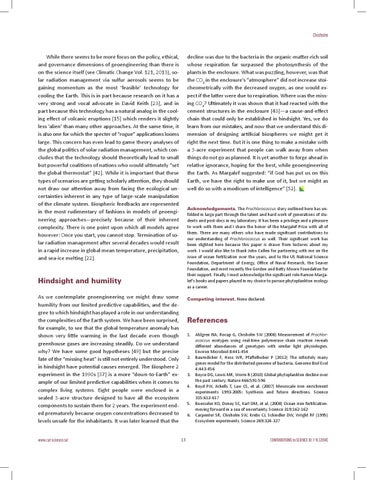Chisholm
While there seems to be more focus on the policy, ethical, and governance dimensions of geoengineering than there is on the science itself (see Climatic Change Vol. 121, 2013), solar radiation management via sulfur aerosols seems to be gaining momentum as the most ‘feasible’ technology for cooling the Earth. This is in part because research on it has a very strong and vocal advocate in David Keith [23], and in part because this technology has a natural analog in the cool ing effect of volcanic eruptions [15] which renders it slightly less ‘alien’ than many other approaches. At the same time, it is also one for which the specter of “rogue” applications looms large. This concern has even lead to game theory analyses of the global politics of solar radiation management, which concludes that the technology should theoretically lead to small but powerful coalitions of nations who would ultimately “set the global thermostat” [42]. While it is important that these types of scenarios are getting scholarly attention, they should not draw our attention away from facing the ecological uncertainties inherent in any type of large-scale manipulation of the climate system. Biospheric feedbacks are represented in the most rudimentary of fashions in models of geoengineering approaches—precisely because of their inherent complexity. There is one point upon which all models agree however: Once you start, you cannot stop. Termination of solar radiation management after several decades would result in a rapid increase in global mean temperature, precipitation, and sea-ice melting [22].
decline was due to the bacteria in the organic-matter-rich soil whose respiration far surpassed the photosynthesis of the plants in the enclosure. What was puzzling, however, was that the CO2 in the enclosure’s “atmosphere” did not increase stoicheometrically with the decreased oxygen, as one would expect if the latter were due to respiration. Where was the missing CO2? Ultimately it was shown that it had reacted with the cement structures in the enclosure [43]—a cause-and-effect chain that could only be established in hindsight. Yes, we do learn from our mistakes, and now that we understand this dimension of designing artificial biospheres we might get it right the next time. But it is one thing to make a mistake with a 3-acre experiment that people can walk away from when things do not go as planned. It is yet another to forge ahead in relative ignorance, hoping for the best, while geoengineering the Earth. As Margalef suggested: “if God has put us on this Earth, we have the right to make use of it, but we might as well do so with a modicum of intelligence” [52]. Acknowledgements. The Prochlorococcus story outlined here has unfolded in large part through the talent and hard work of generations of students and post-docs in my laboratory. It has been a privilege and a pleasure to work with them and I share the honor of the Margalef Prize with all of them. There are many others who have made significant contributions to our understanding of Prochlorococcus as well. Their significant work has been slighted here because this paper is drawn from lectures about my work. I would also like to thank John Cullen for partnering with me on the issue of ocean fertilization over the years, and to the US National Science Foundation, Department of Energy, Office of Naval Research, the Seaver Foundation, and most recently the Gordon and Betty Moore Foundation for their support. Finally, I must acknowledge the significant role Ramon Margalef’s books and papers played in my choice to pursue phytoplankton ecology as a career.
Hindsight and humility As we contemplate geoengineering we might draw some humility from our limited predictive capabilities, and the degree to which hindsight has played a role in our understanding the complexities of the Earth system. We have been surprised, for example, to see that the global temperature anomaly has shown very little warming in the last decade even though greenhouse gases are increasing steadily. Do we understand why? We have some good hypotheses [49] but the precise fate of the “missing heat” is still not entirely understood. Only in hindsight have potential causes emerged. The Biosphere 2 experiment in the 1990s [37] is a more “down-to-Earth” example of our limited predictive capabilities when it comes to complex living systems. Eight people were enclosed in a sealed 3-acre structure designed to have all the ecosystem components to sustain them for 2 years. The experiment ended prematurely because oxygen concentrations decreased to levels unsafe for the inhabitants. It was later learned that the www.cat-science.cat
Competing interest. None declared.
References 1. Ahlgren NA, Rocap G, Chisholm SW (2006) Measurement of Prochlor ococcus ecotypes using real-time polymerase chain reaction reveals different abundances of genotypes with similar light physiologies. Environ Microbiol 8:441-454 2. Baumdicker F, Hess WR, Pfaffelhuber P (2012) The infinitely many genes model for the distributed genome of bacteria. Genome Biol Evol 4:443-456 3. Boyce DG, Lewis MR, Worm B (2010) Global phytoplankton decline over the past century. Nature 466:591-596 4. Boyd PW, Jickells T, Law CS, et al. (2007) Mesoscale iron enrichment experiments 1993-2005: Synthesis and future directions. Science 315:612-617 5. Buesseler KO, Doney SC, Karl DM, et al. (2008) Ocean iron fertilizationmoving forward in a sea of uncertainty. Science 319:162-162 6. Carpenter SR, Chisholm SW, Krebs CJ, Schindler DW, Wright RF (1995) Ecosystem experiments. Science 269:324-327
13
CONTRIBUTIONS to SCIENCE 10: 7-15 (2014)
